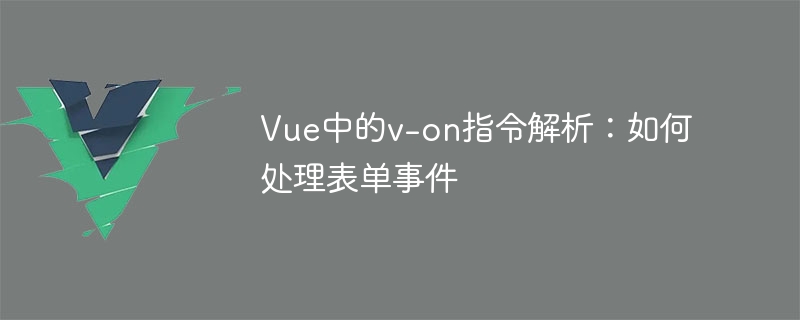

Analysis of the v-on directive in Vue: How to handle form events, specific code examples are required
In Vue, the v-on directive is used to listen to DOM events. And execute the corresponding method when the event is triggered. Through the v-on instruction, we can easily handle form events, such as clicking buttons, submitting forms, entering input boxes, etc. The following will introduce how to use the v-on directive to handle form events and give specific code examples.
First, let's look at a simple example. Suppose we have a button and a method needs to be executed after clicking the button. This can be achieved in Vue:
HTML code:
<div id="app">
<button v-on:click="handleClick">点击我</button>
</div>Vue instance code:
new Vue({
el: '#app',
methods: {
handleClick() {
console.log('按钮被点击了!');
}
}
});In the above example, the click event is bound through the v-on directive Come to the handleClick method. When the button is clicked, the handleClick method will be called and output "The button was clicked!".
In addition to click events, we can also use other event types, such as keyup, submit, etc. Next, I'll show you how to handle other types of form events with more code examples.
HTML code:
<div id="app">
<input v-on:input="handleInput">
<p>{{ message }}</p>
</div>Vue instance code:
new Vue({
el: '#app',
data: {
message: ''
},
methods: {
handleInput(event) {
this.message = event.target.value;
}
}
});In the above example, we pass The v-on directive binds the input event to the handleInput method. When the content of the input box changes, the handleInput method will be called and the input content will be assigned to the message in the data attribute.
HTML code:
<div id="app">
<form v-on:submit="handleSubmit">
<input type="text" v-model="username">
<input type="password" v-model="password">
<button type="submit">提交</button>
</form>
</div>Vue instance code:
new Vue({
el: '#app',
data: {
username: '',
password: ''
},
methods: {
handleSubmit(event) {
event.preventDefault(); // 阻止表单提交的默认行为
console.log('用户名:', this.username);
console.log('密码:', this.password);
}
}
});In the above example, we pass The v-on directive binds the submit event to the handleSubmit method. When the form is submitted, the handleSubmit method is called and outputs the username and password in the input box. Use the event.preventDefault() method to prevent the default behavior of form submission.
Through the above example, we can see that various form events can be easily processed through the v-on instruction. We only need to bind the event to the corresponding method to execute the corresponding logic.
The above is an analysis of how the v-on instruction in Vue handles form events. I hope that the introduction of this article can help everyone better understand and use the v-on instruction.
The above is the detailed content of Analysis of v-on directive in Vue: how to handle form events. For more information, please follow other related articles on the PHP Chinese website!
 How to solve the computer prompt of insufficient memory
How to solve the computer prompt of insufficient memory
 What is the difference between hardware firewall and software firewall
What is the difference between hardware firewall and software firewall
 The role of base tag
The role of base tag
 Eth market analysis today
Eth market analysis today
 How to execute a shell script
How to execute a shell script
 How to register on Matcha Exchange
How to register on Matcha Exchange
 What are the classifications of linux systems?
What are the classifications of linux systems?
 Scope permission opening method
Scope permission opening method




